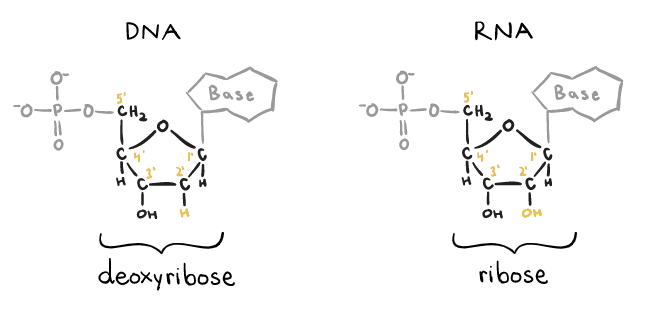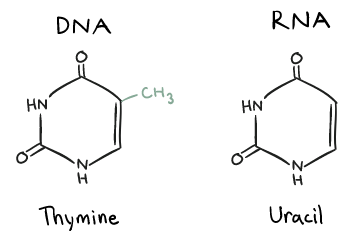MCAT Exam > MCAT Notes > Biochemistry for MCAT > Eukaryotic gene transcription: Going from DNA to mRNA
Eukaryotic gene transcription: Going from DNA to mRNA | Biochemistry for MCAT PDF Download
| Table of contents |

|
| Transcription's Role in Delivering Genetic Instructions |

|
| What does an mRNA transcript look like? |

|
| How is an mRNA transcript made? |

|
| Consider the following: RNA interference |

|
Transcription's Role in Delivering Genetic Instructions
- Inside the cell, genes are securely stored within the nucleus, while ribosomes, the protein assembly machines, reside in the cytosol. This spatial division poses a challenge for the cell: how to transport the instructions encoded in genes to the ribosomes located outside the nucleus.
- The solution, although intricate, can be summarized. The gene instructions, written in the DNA language of nucleotides, are transcribed into a mobile form known as mRNA transcripts. These transcripts escape the confines of the nucleus and travel to the ribosomes, where they convey the vital instructions for protein synthesis. This process of creating mRNA transcripts, enabling the mobility of genetic information, is referred to as gene transcription.
An analogy for understanding transcription
- Let's imagine you're the proud owner of an Italian restaurant. All the cherished recipes used by your talented cooks are stored in a large book, securely kept in your office after closing time. However, one fateful Saturday afternoon, a door malfunction leaves you trapped inside your office along with the precious recipe book. With the restaurant set to open in a few hours, and no available locksmiths on the weekend, how can you ensure the cooks receive the necessary recipes to satisfy the customers' orders?
- Fortunately, you devise a clever system to overcome this predicament. When a customer places an order for a specific dish, the waiter promptly informs you by knocking on your office door. Acting swiftly, you locate the relevant recipe in the book and carefully transcribe it onto a compact 3x5 notecard. Given limited space and time constraints, you employ shorthand and abbreviations while ensuring all essential recipe elements are included. The notecard is then placed inside a sealable plastic bag to protect it from any kitchen mishaps, and skillfully slid under the door crack.
- The diligent waiter retrieves the notecard and swiftly delivers it to the awaiting cook in the kitchen. Armed with the vital information, the cook can now prepare the customer's desired dish flawlessly. Problem solved, albeit with the minor inconvenience of still being locked inside your office.
The mechanics of transcription
- Transcription in cells is akin to copying a recipe onto a 3x5 card and sliding it under an office door.
- The 3x5 card represents an mRNA transcript, which is a single strand of RNA.
- An mRNA transcript carries the information encoded in a gene, similar to how the recipe is encapsulated on the card.
- The mRNA transcript serves as a portable version of the gene, smaller and more mobile than the DNA sequence it originates from.
- Despite its compact size, the mRNA transcript contains the same essential information as the original gene.
What does an mRNA transcript look like?
When trying to comprehend new information, it's helpful to relate it to something you already know. In the case of mRNA transcripts, you can draw a parallel with a single strand of DNA (assuming you have knowledge of DNA structure and function from our previous article).
Visualize a picture of a DNA strand in your mind, and then make two modifications to transform it into an mRNA transcript.
- Add a hydroxyl group to the 2' carbon of each deoxyribose. In biochemistry terminology, this process is referred to as hydroxylation of the 2' deoxyriboses.

- Secondly, remove the methyl group from every thymine present in the nucleotide strand. In the language of biochemistry, this process is known as demethylation of each thymine.

To better grasp the subtle differences between DNA and RNA, consider the following comparison:
- Deoxyribose, found in DNA, is hydroxylated to become ribose in RNA.
- Thymine in DNA is demethylated and replaced by uracil in RNA.
It is important to note that cells do not convert DNA into mRNA by directly modifying a DNA strand. Instead, they synthesize mRNA from scratch using pre-existing supplies of ribose, uracil, and other nucleotide components. However, by envisioning these changes starting from a DNA strand, we can better understand the chemical structure of mRNA.
How is an mRNA transcript made?
- An enzyme called RNA polymerase II is responsible for synthesizing an mRNA transcript. Similar to DNA polymerase, which functions in DNA replication, RNA polymerase II operates on a DNA template. However, the key distinction lies in the building blocks used.
- DNA polymerase utilizes a DNA template to synthesize a complementary DNA strand. Each nucleotide in the newly synthesized DNA strand matches its counterpart in the template strand. Conversely, RNA polymerase II also employs a DNA template, but instead of synthesizing a complementary DNA strand, it generates a complementary RNA strand—the mRNA transcript.
mRNA processing
- mRNA processing occurs after the RNA polymerase has completed transcription and involves two main phases: protection and splicing. These processes are necessary for the mRNA transcript to successfully exit the nucleus and reach the ribosome.
- During the protection phase, modifications are made to the ends of the mRNA transcript to safeguard it from degradation. A modified 5' cap is added to the beginning of the mRNA molecule, which helps in stabilizing the transcript and facilitating its recognition by the ribosome. Additionally, a poly-A tail consisting of multiple adenine nucleotides is attached to the 3' end of the mRNA. This tail plays a role in protecting the mRNA from degradation and aids in its transport.
Protection
- During the protection phase of mRNA processing, specific nucleotide sequences are added to the ends of the mRNA transcript to safeguard it from degradation outside the nucleus. The 5' end of the transcript receives a single G nucleotide, forming the 5' cap. At the 3' end, a long sequence of A nucleotides, known as the poly-A tail, is attached. These modifications serve as protective measures against enzymatic degradation by exonucleases in the cytoplasm, which target RNA molecules with exposed 5' ends.
- To understand this protection phase in the context of our restaurant analogy, imagine that you want to shield the 3x5 recipe card from potential damage in the kitchen. Just like you place the recipe card inside a plastic bag to protect it from water, oil, or other ingredients that could affect the ink and message, the 5' cap and poly-A tail serve a similar protective purpose for the mRNA transcript. They act as safeguards, preserving the integrity of the transcript during its journey from the nucleus to the ribosome, preventing its degradation by exonucleases.
Splicing
- The second phase of mRNA processing is known as splicing, which involves removing the introns from the mRNA transcript. Introns are sequences of RNA that do not contain information about protein construction. The task of removing introns is performed by a complex of enzymes called a spliceosome. The spliceosome identifies and excises the introns, joining the remaining segments of the mRNA transcript back together. These remaining segments, which contain the protein assembly instructions, are referred to as exons. The mRNA transcript that still contains introns is often called pre-mRNA, while the intron-free transcript produced by the spliceosome is referred to as primary mRNA or mature mRNA.
- In terms of our restaurant analogy, consider the recipes in the big book that may contain additional information like origins, family history, or pairing suggestions. However, for the specific purpose of preparing a dish, such information is irrelevant and can be excluded when creating the notecard. Only the essential information needed for making the dish is included, corresponding to the exons in transcription. The introns, analogous to the extraneous details, can be left out. This process results in a smaller and more portable version of the mRNA transcript.
- Once mRNA has undergone protection and splicing, it is prepared to leave the nucleus and enter the second phase of protein synthesis, known as translation.
Consider the following: RNA interference
Let's imagine in our restaurant analogy that if the notecard you slid under the door never reached the kitchen, the dish wouldn't be prepared because the cook wouldn't have the recipe, right?
- In recent years, a promising category of medical therapies called RNA interference has utilized a similar concept to develop innovative treatments for various challenging diseases. These therapies disrupt the production of harmful proteins by intercepting and disabling mRNA transcripts before they reach the ribosomes. Consequently, the corresponding proteins are prevented from being synthesized in the first place.
- An exceptional application of RNA interference techniques is the proposed treatment for Ebola. Ebola, like most viruses, operates as a transcription machine. It possesses a viral genome, akin to a small and simple chromosome, along with a polymerase enzyme. Once the virus infiltrates a host cell, the polymerase enzyme generates mRNA transcripts for each gene in its genome. It then hijacks the host's ribosomes to produce its own proteins, which facilitate the assembly of new Ebola viruses.
- An apparent strategy to combat Ebola is to disrupt this entire process and halt replication before it commences. Scientists have demonstrated that by employing a class of engineered molecules known as short interfering RNA (siRNA), the viral mRNAs synthesized by the Ebola virus within infected cells can be captured and destroyed. This prevents the delivery of their genetic messages to the host cell's ribosomes. With no Ebola mRNA, the production of Ebola proteins is impeded, thereby diminishing the virus's ability to replicate within host cells.
- As with any new therapies, siRNA-based treatments for Ebola were initially validated in non-human animal models. However, during the recent outbreak of the virus in West Africa, followed by its spread to North America, the U.S. Food and Drug Administration took the extraordinary step of granting a "compassionate use" exemption for an siRNA-based Ebola therapy called TKM-ebola. While specific details are limited, we are aware that TKM-ebola was administered to several patients and may have contributed to their subsequent recoveries.
The document Eukaryotic gene transcription: Going from DNA to mRNA | Biochemistry for MCAT is a part of the MCAT Course Biochemistry for MCAT.
All you need of MCAT at this link: MCAT
|
138 videos|21 docs|26 tests
|
Related Searches














